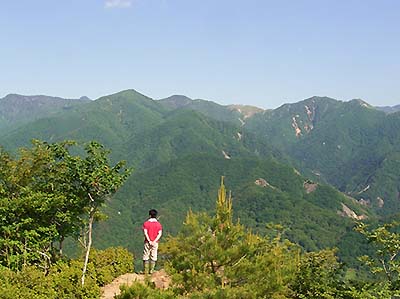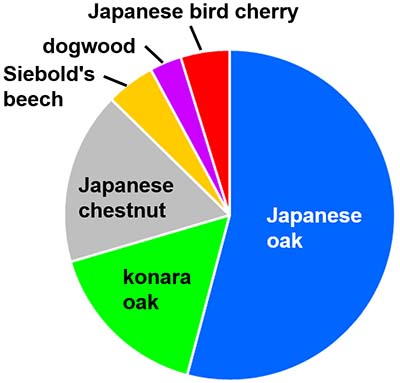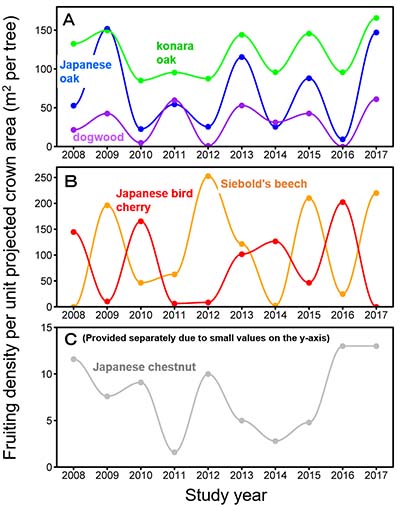Home > Research > Research Results > Research Results 2020 > Spatial aggregation of fruiting trees within a landscape
Update:June 8, 2020
Main content starts here.
Spatial aggregation of fruiting trees within a landscape
| Article title |
Horizontal and elevational patterns of masting across multiple species in a steep montane landscape from the perspective of forest mammal management |
||||
|---|---|---|---|---|---|
| Author (affiliation) |
Takashi Masaki (a), Shin Abe (b), Shoji Naoe (c), Shinsuke Koike (d), Ami Nakajima (e), Yui Nemoto (f), Koji Yamazaki (g) (a) Principal Research Director, FFPRI, Tsukuba, Ibaraki, Japan. (b) Department of Forest Vegetation, FFPRI, Tsukuba, Ibaraki, Japan. (c) Tohoku Research Center, FFPRI, Morioka, Iwate, Japan. (d) Tokyo University of Agriculture and Technology, Fuchu, Tokyo, Japan. (e) Tama Zoological Park, Hino, Tokyo, Japan. (f) Fukushima Prefectural Centre for Environmental Creation, Miharu, Fukushima, Japan. (g) Tokyo University of Agriculture, Setagaya, Tokyo, Japan. |
||||
| Publication Journal |
Journal of Forest Research, March 2020 DOI:10.1080/13416979.2020.1744231( External link ) |
||||
| Content introduction |
There is a wide variety of tree species growing in Japan, and they are ecologically connected with a wide variety of wildlife. For example, fruit-bearing trees provide food for wildlife. However, it has not been known how each of these tree species varies its fruiting density, both spatially and temporally, in the extensive home ranges of large wild animals. Therefore, in a 30km X 30km forested landscape of the Ashio Mountains/Nikko Mountains massif in the North Kanto region (see photo), which corresponds to the areal extent of the range of the local population of Asiatic black bears during the pre-hibernation foraging season, the fruiting density of about 400 trees of 6 major tree species that produce acorns or fleshy fruits was surveyed over a 10-year period in an attempt to answer these questions. As a result of this survey, it was found that Japanese oak was by far the main tree species that provided fruits in the survey area, followed by Konara oak and Japanese chestnut (Fig. 1). During the 10 years of the study, Japanese oak, Konara oak and dogwood synchronized their fruiting density with one another (Fig. 2). Because of this, in years when Japanese oak produced many fruits, the second major species, Konara oak, also produced many fruits, and in years when Japanese oak produced few fruits, so did Konara oak. There was no particular synchronization trend found with fruits of other tree species. Furthermore, while every tree species in the entire survey area tended to synchronize their fruit production, Japanese oak and Konara oak tended to synchronize well among themselves, especially within a distance of 5 to 7km. As a result, we could see that even in years when fruits of Japanese oak and other species are abundant, there can be spatial aggregations of fruiting trees, depending on the location in the survey area. These findings have helped us to gain a better understanding of the effect that fruiting conditions of forests in montane areas have on the foraging behavior of wild animals such as Asiatic black bears, and will make a significant contribution to the conservation and management of wildlife in forested areas.
|
Copyright © Forest Research and Management Organization. All rights reserved.



